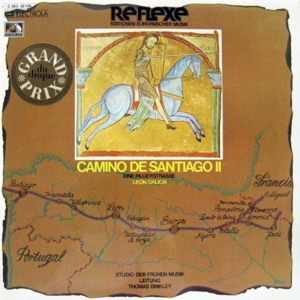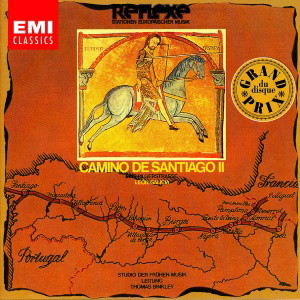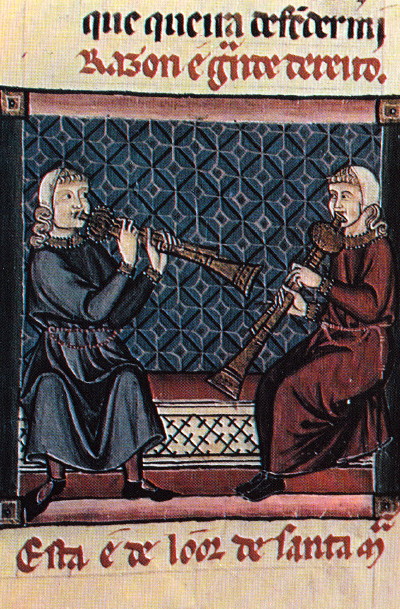 |
1 LP -
1C 063-30 108 - (p) 1973
|

|
| 1 CD - 8
26475 2 - (c) 2000 |
|
CAMINO
DE SANTIAGO II - Eine Pilgerstraße
Léon-Galicia
|
|
|
|
|
|
| LÉON |
|
|
1. Ben com
(Cantiga 49) - Sängerin, Laute
|
10' 31" |
|
2. De grad
(Cantiga 253) - Vokalensemble,
Laute, Vielle (Fiedel)
|
13' 25" |
|
|
|
|
| GALICIA |
|
|
| 3. Dum pater
familias (Lateinisches Lied) -
SVokalensemble,
Laute, Rebec |
5' 40" |
|
4. A madre
(Cantiga 184) - Vokalensemble,
Laute, Vielle (Fiedel), Lira,
Organetto, Schlagzeug
|
6' 50" |
|
| 5. Nostra
phalans (Conductus) - Sängerin,
Sänger
|
2' 21" |
|
| 6.
Sol eclysim (Planctus) - Sängerin,
Sänger,
2 Schalmeien (Shawms)
|
5' 11" |
|
|
|
|
STUDIO DER FRÜHEN
MUSIK / Thomas Binkley, Leitung
|
|
| -
Andrea von Ramm, Sängerin
(1,2,3,4,5,6), Organetto (2,4) |
|
| -
Richard Levitt, Sänger
(2,3,4,5,6) |
|
-
Sterling Jones, Streichinstrumente,
Schalmei (Shawm)
|
|
-
Thomas Binkley, Zupfinstrumente,
Schalmei (Shawm)
|
|
| mit |
|
| -
Carlos
Aúz Castro, Sprecher |
|
| -
Peter Schranner, Sänger
(2,3,4) |
|
| -
Josef Weber,
Sänger (2,4) |
|
| -
Johannes
Fink, Vielle (Fiedel) |
|
| -
Roberto C. Détrée,
Schlaginstrumente |
|
|
|
|
|
Luogo
e data di registrazione |
|
Bürgerbräu.
München (Germania) - 1972
|
|
|
Registrazione: live /
studio |
|
studio |
|
|
Producer / Engineer |
|
Gerd
Berg / Wolfgang Gülich
|
|
|
Prima Edizione LP |
|
EMI
Electrola "Reflexe" - 1C 063-30
108 - (1 lp) - durata 43' 57" -
(p) 1973 - Analogico |
|
|
Prima Edizione CD |
|
EMI
"Classics" - 8 26475 2 - (1 cd) -
durata 43' 57" - (c) 2000 - ADD |
|
|
Note |
|
- |
|
|
|
|
|
 Medieval
Music along
the Prigrim Route of Saint
James, 13th Century Medieval
Music along
the Prigrim Route of Saint
James, 13th Century
The story began in Jaffa,
today an Arab town just
outside of Tel Aviv, where in
the first century Jacob war
born, brother of John and son
of Zebedeo and Maria
Salomé,
who was the sister of Mary,
mother of
Jesus. This direct connection
to the Holy Family lends
importance to the place
containing the remains of the
evangelist St. James.
James - Jacob - Iago - Saint
Iago - Santiago went to Spain
to preach and returned
eventually to Jerusalem, where
he was decapitated by Herodes
Agrippa some ten or twelve
years after the death of
Jesus. His remains were
brought back to Spain, to rest
in the palace of a wealthy
follower. Centuries passed,
armies came and went, and then
in the ninth century with the
aid of a miraculous light, a
hermit rediscovered the
sepulchre. Today this place
is called Santiago de
Compostela, St. James in the
Field of Stars. Thus it was
that Santiago de Compostela
joined Jerusalem (Holy
Sepulchre) and Rome (St.
Peters) as one of the focal
points of Christian
pilgrimage.
The Camino, the road leading o
Santiago is really a complex
of many roads coming from
different places, the Camino
del Mar, the Camino
Portugués,
the Camino de Cataluña
etc. It
was however the Camino
Francés which was the
most important for it was the
most international. Pilgrims
from all over Europe walked
and rode over its many byways
for centuries.
At reasonable distances along
the route were hostles where
the pilgrims might stop over,
these frequently being
operated by monasteries.
Pilgrims enjoyed a
considerable civil protection
under the law, and were
entitled to free food and
lodging as well as to
information about the roads
and bridges and the location
of potable water between
hostles. In
some places this is still true
today for bona fide pilgrims.
Of all the adventures that
happened along the Camino, the
religious adventures take
precedence. The miracles of
Our Lady are to some extent
recorded in the Cantigas of
Alfonso X El Sabio, the
Cantigas de Santa Maria,
one of our main sources here.
Not all of the music along the
Camino told of miracles -there
are hymns and exaltations as
well.
This then is what these
recordings are about. The
songs tell about specific
happenings along the Camino,
and for the most part, the
places where they happened are
still there and can be
visited. So we make our own
pilgrimage in sound along the
Camino Francés,
through Navarra, Castile, León and
ending in Galicia, the
province of Santiago de
Compostela.
What is the music? It is
the meeting of the way between
folk music of the past and
profound poetry. It is a
natural music, built on text
and melody and improvisation,
the really human elements of
the musical art. It has also a
touch of the speculative or
cogitative qualities that
catch the mind and bind the
listener.
Christian and Moorish elements
join together, poems in the
form of the Arabic zejel
performed with a Moorish
orchestra, Latin conducti in
the Roman tradition... but
music can seldom be described
it must
be heard. Here is a coileotion
of surprising scope,
encompassing some of the most
grandiose music of the Middle Ages
and some of the most intimate.
LEON
Ben
com' aos que van per mar a
estrela guia
Cantiga 49
Along the
Camino Francés between
Burgos and León is the town
of Sahagún, historically
important for the
introduction of the Cluniac
reform into León in the 11th
century. South of the city
on the hill is the 13th
century church of the
Franciscan monastery La
Perigrin. Here the Pilgrim
Virgen is
venerated who, as told in
this story, converted her
staff into a ray of light
to guide the pilgrims by
night..
De
grad a Santa Maria
Cantiga
253
Between Burgos
and León, some 377
kilometers from Santiago de
Compostela, lies Villalcazár
de Sirga, originally Santa
Maria de Villasirga or
simply Villasirga. Here we
find the church of Santa
Maria la Blanca, dating from
the early 12th century and
containing the sepulchre of
Don Felipe and Doña Leonor.
Don Felipe was the
reconqueror of Sevilla and
brother of Alfonso X el
Sabio, compiler of the
Cantigas de Santa Maria, and
perhaps it is in that
connection that we find here
the Virgen of the Cantigas,
to whom so many miracles
have been attributed. The
miracle desribed in this
cantiga occured before the
altar of this church, above
the tomb of Don Felipe and
Doña Leonor.
GALICIA
Dum
Pater familias
Latin
Song
Appended to
the Codex Calixtinus is a
leaf, possibly older than
the rest, containing this
pilgrim song. Perhaps it
was well known, and
perhaps it once had a text
entirely in the vernacular
- the present text is
mixed Latin and
vernacular. The
transcription of the
melody and the text is
that of Eusebio
Goicoechea, who suggests
that the song had some
didactic intent, for
example through bringing
the name Santiago in
several declentions,
Iacobus, Iacobi, Iacobo.
A
madre de Deus
Cantiga 184
Somewhere in
the mountains along the
present border between
León and Galicia, perhaps
in the region of the
Senora de Picos with its
peak of 2214 meters, lived
the woman whose story is
told in this cantiga.
Nostra
phalans plaudat
Conductus
The Codex
Calixtinus mentioned above
several times, is indeed a
pilgrims' guide book. Yet
it contains in addition a
lot of music of 12th
century Santiago ge
Compostela. Many of the
songs are specifically
devoted to St. James, as
is this one, which reminds
the singer and the
listener of the story
behind Santiago de
Compostela.
Sol
eclysim Planctus
Fernando II, King of León,
was not permitted the
distinction earned by his
brother Alfonso VIII (see
above). His hopes of
adding Portugal to his
domain were of no lasting
significance. Yet on his
death a planctus was
written which was destined
to survive in a manuscript
in Florence, with music
probably adapted from some
other poem in as much as
the musical and poetic
structures differ, The
performance style given
this monophonic piece is
that of Friuli and many
other European country
traditions preserved today
only in remote areas. Two
shawns form a frame around
the text, while the
singers employ a singular
sort of improvised
counterpoint employing
much dissonance and
steriotyped cadences that
differ greatly from the clausula
vera of the High
western tradition.
Thomas
Binkley
|
|
|
EMI Electrola
"Reflexe"
|
|
|
|

